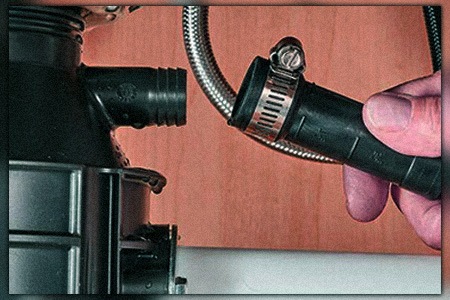Handy Methods for Fixing a Dripping Garbage Disposal
Handy Methods for Fixing a Dripping Garbage Disposal
Blog Article
This great article down below about Why Is My Garbage Disposal Leaking From the Bottom? is amazingly captivating. Read it for yourself and see what you think about it.

Waste disposal unit are important kitchen area devices that aid in throwing away food waste successfully. Nonetheless, a dripping waste disposal unit can be a discouraging and unpleasant issue to handle. The good news is, lots of leaks can be dealt with conveniently with a few easy actions. In this write-up, we will talk about how to deal with a leaking waste disposal unit efficiently.
Intro
Garbage disposals are set up under kitchen area sinks and are created to shred food waste right into smaller items, allowing it to pass through the pipes system quickly. While these devices are typically reputable, leaks can happen with time as a result of wear and tear, loose connections, or damage to the device.
Usual Reasons For Leaks in Waste Disposals
Worn Seals and Gaskets
Seals and gaskets play an important function in preventing water from dripping out of the garbage disposal. Over time, these components can deteriorate, bring about leakages around the disposal unit.
Loose Connections
The links between the waste disposal unit and the pipes system can end up being loose over time, triggering water to leak out throughout operation.
Fractures or Openings in the Disposal Unit
Physical damages to the waste disposal unit, such as fractures or holes in the real estate, can also cause leaks.
Identifying the Source of the Leak
Before trying to deal with a leaking garbage disposal, it is important to determine the resource of the leak. This can generally be done with aesthetic assessment or by carrying out easy examinations.
Visual Examination
Check the garbage disposal unit very carefully for any indicators of water leak. Pay close attention to areas around seals, gaskets, and link points.
Checking for Leakages
One means to evaluate for leakages is by running water via the disposal system and looking for any noticeable signs of leakage.
Devices and Materials Needed for Dealing With a Leaking Waste Disposal Unit
Before beginning the repair service process, collect the necessary devices and materials, consisting of a screwdriver, flexible wrench, plumbing's putty, replacement seals or gaskets, and epoxy or patching material for repairing splits or holes.
Step-by-Step Guide to Fixing a Leaking Garbage Disposal
Switch off the Power
Before attempting any kind of repairs, ensure that the power to the garbage disposal unit is turned off to prevent the threat of electrical shock.
Find the Leak
Determine the specific place of the leak and figure out the reason.
Tighten Connections
Use a wrench to tighten up any kind of loosened links between the disposal device and the plumbing system.
Change Seals or Gaskets
If the leakage is because of used seals or gaskets, get rid of the old elements and replace them with brand-new ones.
Patching Cracks or Holes
For cracks or openings in the disposal system, use epoxy or an appropriate patching material to secure the broken area.
Testing the Waste Disposal Unit After Fixing
When the repair work is total, evaluate the waste disposal unit by running water via it to ensure that the leak has actually been dealt with.
Preventive Maintenance Tips to Stay Clear Of Future Leaks
To avoid future leakages, it is necessary to perform routine maintenance on your garbage disposal. This includes keeping it clean, staying clear of putting non-food products or hard things down the disposal, and occasionally looking for leakages or various other problems.
Verdict
Finally, dealing with a dripping waste disposal unit is a fairly uncomplicated process that can be finished with standard devices and products. By adhering to the steps laid out in this short article and exercising preventive maintenance, you can maintain your garbage disposal in good working problem and prevent pricey repair services in the future.
What to Do About a Leaking Garbage Disposal
A leaking garbage disposal often goes unnoticed until you confront a sopping cabinet, a foul-smelling puddle, or an audible drip-drip-drip from the unit. The fix can be frustrating, too, because the leak can stem from a number of components in the system. Fortunately, with a little sleuthing, you can zero in on the leak and—depending on the exact location—stop the icky oozing and repair the component that caused it. Worst case scenario, if it turns out that the garbage disposal must be replaced, installing a new one is a reasonable do-it-yourself task for those with basic plumbing skills. Read on to keep the cash you’d otherwise hand over to a pro.
Prepare to find the leak
Prior to testing the garbage disposal for leaks, unplug it at the wall outlet and turn off the power from the breaker box to prevent electrical shock. Then insert a watertight sink stopper into your sink drain and wipe the unit dry with a clean cloth. In any handy container, mix a few drops of food coloring into a few cups of water, and pour the dyed water onto the sink stopper to help you locate the leak.
Investigate the source
the top, where the disposal meets the sink drain the side, where the dishwasher hose or main drain pipe connects to the disposal or the bottom of the unit Inspect each of these locations while gliding a light-colored rag over the unit; the dyed water will readily show on the rag and reveal the location of the leak. If a leak isn’t immediately apparent, remove the sink stopper and pour a few more cups of dyed water down the sink drain, then check for leaks again. Leaks near the top of the unit are more likely to show themselves while the sink is plugged, while side and bottom leaks are more noticeable while the sink is unplugged.
The metal sink flange that sits directly inside the sink drain is typically sealed around the top with plumber’s putty (a clay-like sealant) and then secured from under the sink with bolts. If the plumber’s putty deteriorates, or the bolts loosen, the flange can no longer form a watertight seal between the sink drain and the disposal—which could cause a leak at the top of the unit.
To reseal the leaky flange, you must first detach the garbage disposal. Start by loosening the screws securing the main drain pipe to the disposal, then loosen the screws in the metal clamp securing the dishwasher hose to the disposal and detach the drain pipe and dishwasher hose from the disposal. Loosen the screws in the mounting ring that connects the disposal to the metal mounting assembly beneath the sink, then pull down the disposal and carefully set it on a clean, dry surface. Loosen the bolts in the mounting assembly with a wrench, then pull down the mounting assembly and set it near the disposal.

I came across that blog posting on Garbage Disposal Leaking From Bottom while browsing on the web. Do you know another person who is inquisitive about the subject? Be sure share it. We treasure reading our article about The Handy Guide To Fixing Your Garbage Disposal Leaking.
Visit Report this page